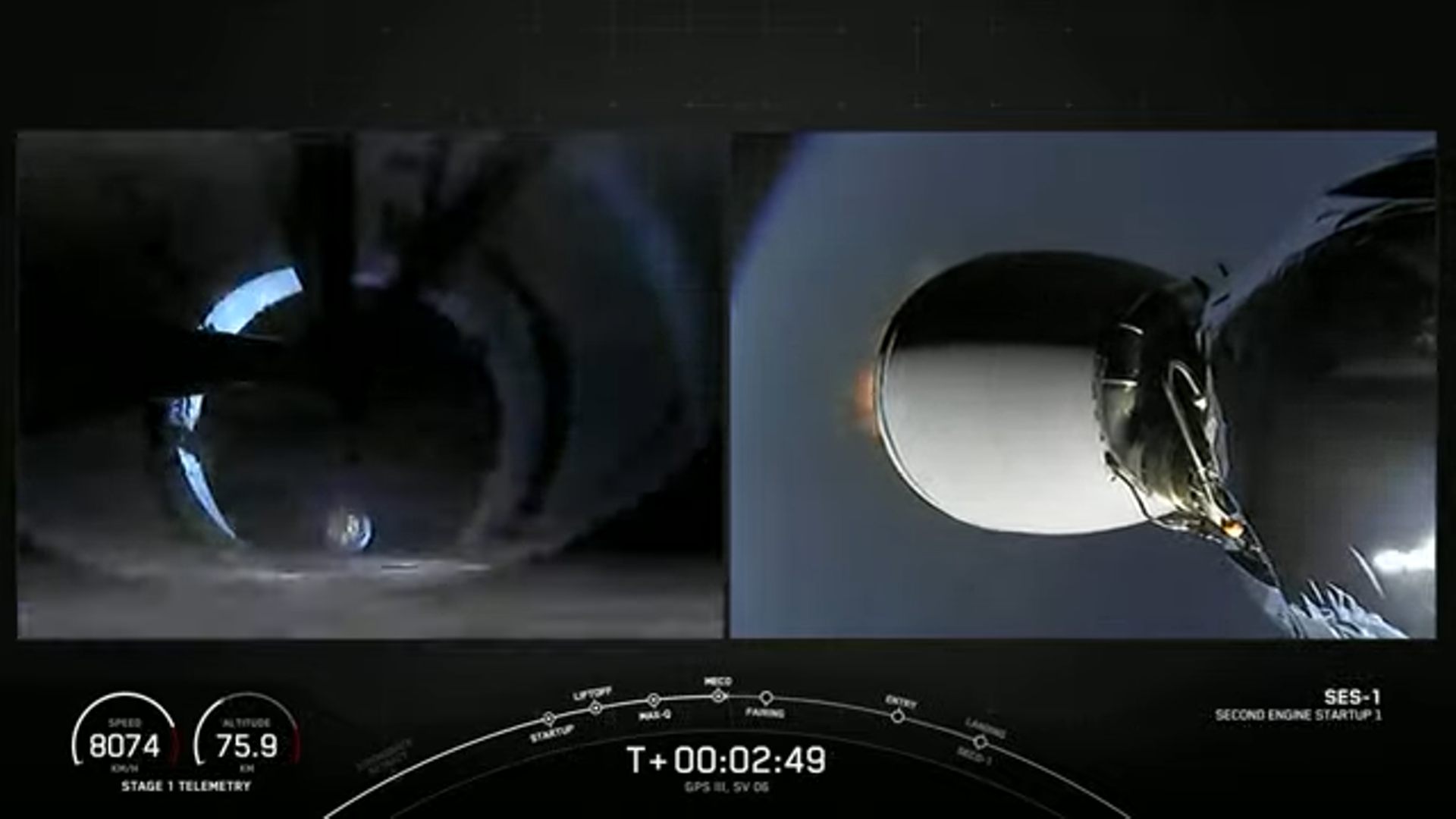
Taking full advantage of a week of dry air, mild temperatures and generally favorable weather along the Space Coast, a twice-flown Falcon 9 booster took flight from storied Space Launch Complex (SLC)-40 at Cape Canaveral Space Force Station, Fla., early Wednesday, laden with the U.S. Space Force’s sixth Block III Global Positioning System (GPS III-06) navigation and timing satellite. Liftoff of B1077—which previously saw service to loft Dragon Endurance and her Crew-5 quartet of NASA astronauts Nicole Mann and Josh Cassada, Japan’s Koichi Wakata and Russian cosmonaut Anna Kikina to the International Space Station (ISS), last 5 October—took place at 7:24 a.m. EST.


In keeping with tradition, all Block III GPS birds are named for long-gone explorers, with GPS III-01 and GPS III-02—the first of which rode a SpaceX Falcon 9 in December 2018, the second a United Launch Alliance (ULA) Delta IV Medium the following August—recognizing “Age of Sail” navigators Amerigo Vespucci and Ferdinand Magellan. The third satellite, launched by SpaceX in June 2020, initially recognized Christopher Columbus, but was later renamed for the early 20th-century polar pioneer Matthew Henson.
More recently, November 2020’s GPS III-04—which went on to complete its on-orbit commissioning in record-setting time—paid tribute to Sacagawea, a Lemhi Shoshone woman of Idaho, who, aged just 16, aided the Lewis and Clark Expedition to explore the Louisiana Territory in 1803-1806. And GPS III-05, launched in June 2021, bore the name of Neil Armstrong, the first human to set foot on the Moon.

Today’s GPS III-06 is named for Amelia Earhart, the first woman to fly solo across the Atlantic. Born in Atchison, Kan., on 24 July 1897, Earhart was an adventurer from childhood, gaining flying experience in her twenties and in 1928 becoming the first female passenger to cross the Atlantic by airplane.
Four years later, on 20 May 1932, piloting a Lockheed Vega 5B high-wing monoplane, she made a non-stop solo transatlantic flight, becoming the first woman to do so. In 14 hours and 56 minutes that day, having battled icy conditions, mechanical problems and strong northerly winds, Earhart flew from Harbour Grace, in eastern Newfoundland, to land in a pasture at Culmore, north in Derry in Northern Ireland.

When she alighted in that Irish pasture, a farmhand is said to have asked her if she had traveled far. “From America,” Earhart nonchalantly retorted.
She earned worldwide fame and recognition, which made her disappearance in July 1937 all the more shocking. Flying with navigator Fred Noonan on an attempted circumnavigation of the globe, their Lockheed Model 10E Electra twin-engine monoplane was lost over the Pacific Ocean.

They had last been seen in Lae, New Guinea, heading to the northwest towards Howland Island, with expectations that they would travel onward to Honolulu. Eighteen months later, the pair were declared officially deceased, although speculation as to what happened to them more than eight decades ago continues to arouse debate.
GPS III-06, bearing Earhart’s name, is part of a next-generation constellation of global positioning, velocity and timing satellites. Each is destined for Medium Earth Orbit (MEO) at a mean altitude of 12,550 miles (20,200 kilometers).

Building upon a GPS Navstar heritage, which dates back to the 1970s, Block III got underway more than two decades ago. The Air Force awarded Lockheed Martin a $1.4 billion contract in May 2008 to develop an initial pair of Block III satellites for an eventual 32-satellite network.
The first launch was targeted for 2014, but payload-related difficulties pushed the program’s maiden flight back almost five years. In the meantime, in March 2018 the Air Force awarded SpaceX a $290.5 million contract to launch the fourth, fifth and sixth Block III satellites.

The first two satellites—GPS III-04 and GPS III-05—were duly launched in November 2020 and June 2021, with today’s flight of GPS III-06 closing out the three-mission contract.
Although SpaceX’s launch services contract is relatively recent, hardware for GPS III-06 has been in the works for almost a decade. Procurement of long-lead-time components for the satellite were awarded by the Air Force in February 2013 and Lockheed Martin received authorization to complete production of GPS III-06 the following December.

By mid-2017, it was reported that components for the new satellite and five others were “arriving…daily from more than 250 supplier in 29 states” and in April 2018 GPS III-06 commenced its structural build-up in Lockheed Martin’s GPS III Processing Facility near Denver, Colo. The satellite concluded its Thermal Vacuum Chamber (TVC) campaign in late 2019 and after reportedly incurring multiple assembly failures during testing was declared “Available for Launch” (AfL) in the late spring of 2021.
Late last October, the 8,500-pound (3,900-kilogram) satellite was shipped from Denver, via the Buckley Space Force Base flightline in Aurora, Colo., en-route to the Astrotech Space Operations facility in Titusville, Fla. Here, GPS III-06 underwent post-shipment functional testing, fueling and encapsulation in its Falcon 9 payload shroud.

Meanwhile, in September 2020—in a decision predicted to save around $52.7 million—the Space Force signed a contract modification with SpaceX to fly aboard previously-flown Falcon 9 boosters. All earlier National Security Space Launches (NSSLs) were executed using only brand-new cores.
But when GPS III-05 launched in June 2021 it did so, for the first time, atop a “used” Falcon 9. So too did last Sunday’s USSF-67 mission, which flew atop a brand-new Falcon Heavy core and two reflown side-boosters.
Responsible for lifting GPS III-06 uphill today was none other than B1077, which entered service last October to deliver Crew-5 to the space station. This particular booster suffered a rather inauspicious start in life, when her transport vehicle impacted a road bridge last summer, during transit from SpaceX’s assembly factory in Hawthorne, Calif., to the rocket development facility in McGregor, Texas.
B1077 sustained damage to her inter-stage during the incident, which reportedly occurred close to Van Horn, Texas. Following repairs and X-ray inspections, she was cleared for flight and last 5 October performed admirably on her maiden outing, returning to land a few minutes later on the expansive deck of the Autonomous Spaceport Drone Ship (ASDS), “Just Read the Instructions”.

In readiness for Wednesday’s launch of GPS III-06, the ASDS “A Shortfall of Gravitas” put to sea from Port Canaveral last Friday, bound for a position offshore in the Atlantic Ocean. Meanwhile, the satellite itself—encapsulated inside its bullet-like payload shroud—was transported to the launch site last weekend.
Weather conditions for both Wednesday’s opening launch attempt at 7:10 a.m. EST, and for Thursday’s backup opportunity at 7:05 a.m. EST, were predicted to hover around 90-percent-favorable, thanks to an ongoing trend of dry air and mild temperatures. “A weakening frontal boundary is expected to stall out to the north of the Spaceport,” noted the 45th Weather Squadron at Patrick Space Force Base in its Tuesday morning L-1 update, “extending favorable launch weather conditions into the primary and backup launch days, with negligible chances for Cumulus Cloud Rule violations.”

Liftoff itself came a little later, at 7:24 a.m. EST, as B1077 powered smoothly uphill in SpaceX’s fourth mission from the Space Coast within January’s first three weeks. Already achieved are the second batch of broadband satellites for London, England-based OneWeb, the 114-strong Transporter-6 rideshare—atop a record-tying, 15-times-flown Falcon 9—and last Sunday’s rousing post-sunset launch of the mammoth Falcon Heavy.
Two and a half minutes into this morning’s ascent, B1077 separated from the stack and descended to a perfect landing on the ASDS, whilst the single Merlin 1D+ Vacuum engine of the Falcon 9’s second stage executed a customary six-minute “burn” to deliver GPS III-06 on the first leg of her trek to MEO. As this AmericaSpace story was being prepared, deployment of the satellite was scheduled to occur about 90 minutes after this morning’s launch.
Ahead lies a phase of on-orbit testing for GPS III-06 before it is declared operational. Like its Block III predecessors, it is based upon Lockheed Martin’s tried-and-true A2100 “bus”, whose modular framework furnishes 15 kilowatts of electricity via high-efficiency solar cells, radiation-cooled traveling-wave tube assemblies and an improved heat-pipe design.
Block III’s 15-year operational lifetime represents a 25-percent quantum leap over earlier GPS satellite capabilities, together with 500 times greater transmitting power, improved navigational warfare abilities, three times better accuracy and an eightfold enhancement in anti-jamming functionality. All told, this enables it to shut off service to limited geographical locations, whilst maintaining uninterrupted provision for U.S. and allied forces.

It features a cross-linked command and control architecture, which permits the entire Block III constellation to be updated from a single ground station. Furthermore, the satellites showcase a “spot-beam” capability for enhanced Military-Code (“M-Code”) coverage and improved resistance to hostile jamming.
With GPS III-06 now in space, three of her sisters are waiting patiently in the wings for their own launches. GPS III-07—named in honor of Sally Ride, America’s first woman in space—was declared Available for Launch (AfL) in May 2022 and is targeting a launch atop ULA’s new Vulcan-Centaur booster next year. GPS III-08 was declared AfL last June and GPS III-09 underwent the integration of its Mission Module and Propulsion Core last May, before heading into environmental testing.






9 Comments
9 Pings & Trackbacks
Pingback:SpaceX Launches 9x-Flown Falcon 9, First Eight-Mission Month Beckons - Space News
Pingback:SpaceX Plans East/West Coast Falcon 9 Launches & Landings, Nine Hours Apart - AmericaSpace
Pingback:SpaceX Plans East/West Coast Falcon 9 Launches & Landings, Nine Hours Apart - Space News
Pingback:SpaceX Launches Inmarsat-6 F2, Other GTO-Bound Missions Wait in Wings - AmericaSpace
Pingback:SpaceX Launches Inmarsat-6 F2, Other GTO-Bound Missions Wait in Wings - Space News
Pingback:As SpaceX Lofts 40 OneWeb Satellites, Relativity Space Aims for Launch Attempt #2 on Saturday - AmericaSpace
Pingback:SpaceX Prepares for Record-Breaking Falcon 9 Launch Today - AmericaSpace
Pingback:SpaceX Prepares for Report-Breaking Falcon 9 Release As of late - NACION ASTRAL
Pingback:SpaceX, ULA Launch Missions, 119 Minutes Apart - AmericaSpace